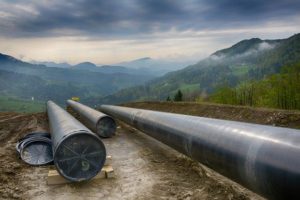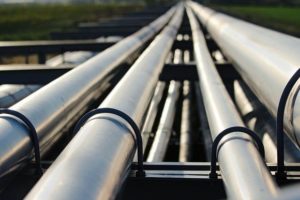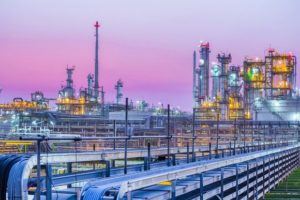Last month the United States decided to impose tariffs on imported steel and aluminum. Wall Street generally considered that to be a boon for American industry, and initially sent shares of steel stocks higher. But if you listened closely enough to the roaring cheers from the crowd it was possible to discern the distinct sound of jaws dropping on the trading floor.
That’s because North America’s shale energy boom has been built largely on the back of foreign steel. The American oil & gas industry will need even more imports to fulfill his destiny as a top global energy exporter within the next decade, especially when building high-pressure pipelines desperately needed to shuttle increasing production volumes to processing facilities and, somewhat ironically, export terminals. An estimated 77% of the steel used in pipelines is sourced from overseas.
Considering that many pipeline operators have big plans for expanding their networks to respond to rising demand and deliver growth to their shareholders and unit holders in the next few years, tariffs have the potential to be painful for the industry if fully implemented. Here’s what investors need to know.

What happened?
The White House announced a 25% tariff on foreign steel and 10% tariff on imported aluminum. The idea is to protect domestic producers who’ve lost market share at home to state-sponsored foreign competitors. On the surface, it seems like a good idea — and the United States is long overdue to wield its considerable leverage at the bargaining table of international trade.
Unfortunately, the steel and aluminum markets aren’t so simple. There are many different grades of steels used for specific applications. Certain specialty grades, such as those required in high-pressure pipelines, are rarely even made in the United States. In fact, few American steel producers currently manufacture products of the diameter needed for pipelines.
In an interview with Reuters, one company estimated that the tariffs could increase the cost to customers by 2% to 4% for a proposed pipeline from West Texas to the Gulf Coast. That’s no minor detail for the fee-based pipeline industry.

What about exemptions?
While Wall Street initially sent shares of steel stocks up on the news of tariffs, most American steel stocks have fallen (some sharply) since the announcement. One big reason: exemptions. Specific companies, industries, and even entire countries have been granted exemptions from the tariffs, sometimes for practical reasons, sometimes for national security purposes.
There’s some good news for pipeline companies. Most important foreign steel manufacturers supplying product for American energy pipelines (and energy infrastructure in general) are in South Korea. Even though the U.S. Department of Commerce recently found that South Korean companies had been illegally dumping steel into the United States, specifically for a category of products called oil country tubular goods, the country was granted an exemption from the latest tariffs. However, it will face a quota on steel export volumes allowed to the United States.
While that should have investors breathing a sign of relief overall, some analysts think just navigating the new regulatory hurdles could slow projects and increase costs.
What pipeline stocks could be affected?
Almost every major pipeline operator has growth projects on tap, but there’s some good news (for now). Most are coming off recently completed projects that won’t be affected by the tariffs, while Kinder Morgan (NYSE: KMI) has nearly half of its five-year $11.8 billion capital budget pledged to its Canadian subsidiary.
The bad news is that although future expansion projects are generally smaller, they may not escape the effects of international trade shake ups.
Enterprise Products Partners LP (NYSE: EPD) has approximately 1,000 miles of pipeline, two processing plants, and two petrochemical facilities under construction or in the works. That includes $1.4 billion in growth projects expected to be completed by the end of 2018 and another $2.8 billion in 2019. The company’s enormous size — over 50,000 miles of pipelines — should provide some insulation from regulatory risks for smaller expansion projects.
Smaller companies such as Crestwood Equity Partners (NYSE: CEQP) may be at slightly more risk. The company has recently made moves to reduce its leverage and demonstrate opportunities to visibly grow earnings and cash flow. Most of that is baked into the future expansion projects of its equity stakes in the Bear Run and Nautilus pipelines, which are expected to deliver $120 million in additional earnings by 2021. More expensive steel could jeopardize that assumption, which could put distribution growth at risk.
The silver lining here is the industry’s fee-based business model. Pipelines generate revenue based on the volumes they transport, which allows them to provide highly visible cash flow growth. While any disruption to project cost estimates upfront represents a risk, any increase in costs could be passed onto customers. That might make American natural gas, crude oil, and other petroleum products slightly more expensive, but it should protect the cash flow of pipeline companies.

Will tariffs stall America’s energy boom?
At the very least, tariffs on imported steel and aluminum make things more complicated for the American energy industry and pipeline operators. But it’s unlikely to be an existential threat. Rather, it could slow the rate of distribution growth and force companies to expedite efforts to reduce leverage. Any shock from higher than expected capital costs on new projects should be temporary, if such a scenario develops at all, as costs can and will likely be passed onto customers.
That said, it’s important to note that pipeline growth projects aren’t critical to every pipeline company. After all, with over 120,000 miles of pipelines between Enterprise Products Partners and Kinder Morgan, even the unlikely decision to cancel a few thousand miles of growth projects won’t move the needle too much. Existing pipeline infrastructure can also accommodate some of the expected volume increases in the next few years. So increasing prices ever so slightly across a nationwide footprint could make up for new tariffs.
In the longer run, Uncle Sam will absolutely need to build new energy pipelines, processing facilities, and export infrastructure to keep up with swelling production. That hints that shaking up the status quo of international trade, while long overdue from a policy perspective, could create a new source of uncertainty that energy investors will need to account for going forward. For now, it’s merely something to keep in mind, not something to base investing decisions upon.


